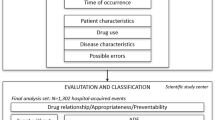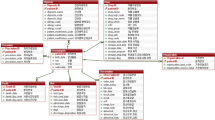Abstract
Objective To analyze adverse drug reaction (ADR) detection using the Minimum Basic Data Set (MBDS) at hospital discharge and to compare the ADR reporting rate to the Pharmacovigilance Referral Centre with other similar hospitals that do not use this reporting system. Setting 650-bed University Hospital serving a population of 294,000 inhabitants in Spain. Method: A retrospective descriptive study was conducted between January 2006 and December 2007. All reports of ADRs gathered in MBDS (a tool that encodes all administrative and clinical information generated for each patient during a hospitalization episode) with International Classification Disease codes between E930 and E949.9 were analyzed to assess the appropriateness of their referral to the pharmacovigilance centre. Finally, we compared our reporting rate with other hospitals that do not use this system for ADR identification. Main outcome measure The incidence of ADRs detected in hospitalized patients and the reporting rate (per thousand inhabitants) to the referral pharmacovigilance centre using the Yellow Card system. Results: Out of 43,282 hospital discharges, 386 ADR were recorded (0.89% of hospitalized patients). The mean (±SD) age of patients with reported ADR was 61.9 years (±19.2), median age was 65 years, and 55.2% were female. The Department of Pharmacy reported 276 (71.5%) of ADR using the Yellow Card system. The most frequently reported drugs were anti-cancer agents (42.5%) and cardiovascular drugs (23.8%), with a high frequency of digitalis glycosides (18.4%). ADR were most frequently recorded by the Departments of Oncology (41.7%) and Internal Medicine (17.9%). Conclusion The MBDS is a useful and accessible instrument to determine the incidence of ADR in a hospital, resulting in the notification of severe events that might otherwise not be reported. Its use also improves identification of the main drugs responsible for ADR and of the patient populations at greatest risk, facilitating the implementation of alert systems and the development of prevention and detection strategies.
Similar content being viewed by others
References
The World Health Organization. The importance of pharmacovigilance. Safety monitoring of medicinal products. Geneva: WHO; 2002. ISBN 92 4 1590157.
Moore N, Montero D, Coulson R, de Abajo FJ, Kreft-Jais C, Biron A, et al. Communication in drug surveillance. Pharmacoepidemiol Drug Saf. 1994;3:151–5.
Patel H, Bell D, Molokhia M, Srishanmuganathan J, Patel M, Car J, et al. Trends in hospital admissions for adverse drug reactions in England: analysis of national hospital episode statistics 1998–2005. BMC Clin Pharmacol. 2007;7:9.
International Drug Monitoring: The Role of National Centres. World Health Organization. Technical Report Series 498. Geneva: World Health Organization; 1972.
ROYAL DECREE 1344/2007, of October 11th, which regulated the drug surveillance of medicines for human use. Boletín Oficial del Estado, no 262, of November 1st, 2007, Madrid (Document on the internet); 2007 (cited 2009 May 30). http://www.boe.es/aeboe/consultas/bases_datos/doc.php?id=BOE-A-2007-18919.
The Uppsala Monitoring Centre (the UMC), WHO Collaborating Centre for International Drug Monitoring, Uppsala (homepage on the Internet); 2009 (cited 2009 May 30). http://www.who-umc.org.
Irujo M, Beitia G, Bes-Rastrollo M, Figueiras A, Hernández-Díaz S, Lasheras B. Factors that influence under-reporting of suspected adverse drug reactions among community pharmacists in a Spanish region. Drug Saf. 2007;30:1073–82.
Van Grootheest AC, van Puijenbroek EP, den Berg LT. Contribution of pharmacists to the reporting of adverse drug reactions. Pharmacoepidemiol Drug Saf. 2002;11:205–10.
Ahmad SR, Freiman JP, Graham DJ, Nelson RC. Quality of adverse drug experience reports submitted by pharmacists and physicians to the FDA. Pharmacoepidemiol Drug Saf. 1996;5:1–7.
Van Grootheest K, Olsson S, Couper M, den Berg L. Pharmacists’ role in reporting adverse drug reactions in an international perspective. Pharmacoepidemiol Drug Saf. 2004;13:457–64.
Ministerial Order of 6 September 1984 establishing the obligation for a hospital discharge report for all patients. B.O.E. no 221 of 14 September; 1984.
Torelló J. Role of the MBDS in drug surveillance. Advantages and limitations of an underused tool. Arch Fac Med Zaragoza. 2001;41(Supll I):24–8.
Sotoca JM, Corominas N, Codina C, Ribas J. Efectos adversos a medicamentos detectados a través del conjunto mínimo básico de datos de las altas hospitalarias. (Adverse drug-related effects detected across the minimaum basic data set at the hospital discharges). El Farmacéutico Hospitales. 2006;174:5–7.
Sánchez Muñoz LA, Castiella Herrero J, Sanjuán Portugal FJ, Naya Manchado J, Alfaro Alfaro MJ. Usefulness of MBDS in detection of adverse drug events. An Med Interna. 2007;24:113–9.
Corral Baena S, Guerrero Aznar MD, Beltrán García M, Salas Turrens J. Use of MBDS as a tool for the detection of drug-related adverse events. Farm Hosp. 2004;28:258–65.
Leonard CE, Haynes K, Localio AR, Hennessy S, Tjia J, Cohen A, et al. Diagnostic E-codes for commonly used, narrow therapeutic index medications poorly predict adverse drug events. J Clin Epidemiol. 2008;61:561–71.
Castillo JR, Merino N, Bejarano MD, Domínguez JC, Fernández G, García J, et al. Results of the program of spontaneous notification of adverse reactions in Andalusia. Year 2006. Alert Drug Surveill 2007; 36:13–16.
Heeley E, Riley J, Layton D, Wilton L, Shakir S. Prescription event monitoring and reporting of adverse drug reactions. Lancet. 2001;358:1872–3.
Aguirre C. Utilization of the hospital MBDS as a source of information in drug surveillance. Summary Book of the III Day Conference on Drug Surveillance, Toledo (document on the internet); 2002 [cited 2009 May 30]. Available from: http://www.jccm.es/sanidad/reuniones/farmacovigilancia/libro.pdf.
Colville R, Laing J, Murison M. Coding plastic surgery operations: an audit of performance using OPCS-4. Br J Plast Surg. 2000;53:420–2.
Waller P, Shaw M, Ho D, Shakir S, Ebrahim S. Hospital admissions for drug induced disorders in England: a study using the Hospital Episodes Statistics (HES) database. Br J Clin Pharmacol. 2004;59:213–9.
Budnitz D, Pollock D, Weidenbach K, et al. National Surveillance of emergency department visits for outpatients adverse drug events. JAMA. 2006;296:1858–66.
Burgess CL, Holman CD, Satti AG. Adverse drug reactions in older Australians, 1981–2002. Med J Aust. 2005;182:267–70.
Caamano F, Pedone C, Zuccala G, Carbonin P. Sociodemographic factors related to the prevalence of adverse drug reaction at hospital admission in an elderly population. Arch Gerontol Geriatr. 2005;40:45–52.
Lazarou J, Pomeranz BH, Corey PN. Incidence of adverse drug reactions in hospitalized patients: a meta-analysis of prospective studies. JAMA. 1998;279:1200–5.
Pirmohamed M, James S, Meakin S, Green C, Scott AK, Walley TJ, et al. Adverse drug reactions as cause of admission to hospital: prospective analysis of 18 820 patients. BMJ. 2004;329:15–9.
Kongkaew C, Noyce P, Ashcroft D. Hospital admissions associated with adverse drug reactions: a systematic review of prospective observational studies. Ann Pharmacother. 2008;42:1017–25.
Romero del Barco R, Ferrando R, Soler E, Blázquez MA, González A, Vilella M. Detection and analysis of adverse drug-related events across the minimum basic data set Atención Farm. Eur J Clin Pharm. 2008;10:143–6.
Fick DM, Cooper JW, Wade WE, Waller JL, Maclean JR, Beers MH. Updating the Beers criteria for potentially inappropriate medication use in older adults: results of a US consensus panel of experts. Arch Intern Med. 2003;163:2716–24.
Wright R, Handler SM, Ruby C, Hanlon JT. Update on drug-related problems in the elderly. Am J Geriatr Pharmacother. 2006;4:78–84.
Brøsen K. Sex differences in pharmacology. Ugeskr Laeger. 2007;169:2408–11.
Anderson GD. Gender differences in pharmacological response. Int Rev Neurobiol. 2008;83:1–10.
Acknowledgments
The authors would like to thank the Hospital Pharmacy Units of Reina Sofia University Hospital, Nuestra Señora de Valme University Hospital and Costa del Sol Hospital for kindly providing us with their notification rates.
Funding
This research did not receive any specific grant from any funding agency in the public, commercial or not-for-profit sector.
Conflicts of interest
The authors declare that there is no conflict of interest that would prejudice the impartiality of this scientific work.
Author information
Authors and Affiliations
Corresponding author
Rights and permissions
About this article
Cite this article
Salmerón-García, A., Cabeza Barrera, J., Vergara Pavón, M.J. et al. Detection of adverse drug reactions through the minimum basic data set. Pharm World Sci 32, 322–328 (2010). https://doi.org/10.1007/s11096-010-9372-2
Received:
Accepted:
Published:
Issue Date:
DOI: https://doi.org/10.1007/s11096-010-9372-2




